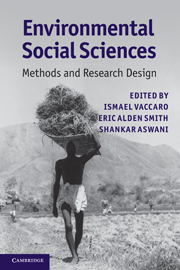Book contents
- Frontmatter
- Contents
- Contributors
- Foreword
- Preface
- 1 Introduction
- 2 People, numbers, and natural resources: demography in environmental research
- 3 Production decisions and time allocation: a guide to data collection
- 4 Analyzing the politics of natural resources: from theories of property rights to institutional analysis and beyond
- 5 Extreme events, tipping points, and vulnerability: methods in the political economy of environment
- 6 Local communities and natural resources: ethnobiology in practice
- 7 Mapping histories: cultural landscapes and walkabout methods
- 8 Metaphors and myths in news reports of an Amazonian “Lost Tribe”: society, environment and literary analysis
- 9 Water decision-makers in a desert city: text analysis and environmental social science
- 10 Linking human and natural systems: social networks, environment, and ecology
- 11 Khat commodity chains in Madagascar: multi-sited ethnography at multiple scales
- 12 Spatiotemporal methodologies in environmental anthropology: geographic information systems, remote sensing, landscape changes, and local knowledge
- 13 Deep time, diachronic change, and the integration of multi-scalar data: archaeological methods for exploring human–environment dynamics
- 14 Comparing trajectories of climate, class, and production: an historical ecology of American yeomen
- 15 Socioecological methods for designing marine conservation programs: a Solomon Islands example
- Index
- References
7 - Mapping histories: cultural landscapes and walkabout methods
Published online by Cambridge University Press: 05 June 2012
- Frontmatter
- Contents
- Contributors
- Foreword
- Preface
- 1 Introduction
- 2 People, numbers, and natural resources: demography in environmental research
- 3 Production decisions and time allocation: a guide to data collection
- 4 Analyzing the politics of natural resources: from theories of property rights to institutional analysis and beyond
- 5 Extreme events, tipping points, and vulnerability: methods in the political economy of environment
- 6 Local communities and natural resources: ethnobiology in practice
- 7 Mapping histories: cultural landscapes and walkabout methods
- 8 Metaphors and myths in news reports of an Amazonian “Lost Tribe”: society, environment and literary analysis
- 9 Water decision-makers in a desert city: text analysis and environmental social science
- 10 Linking human and natural systems: social networks, environment, and ecology
- 11 Khat commodity chains in Madagascar: multi-sited ethnography at multiple scales
- 12 Spatiotemporal methodologies in environmental anthropology: geographic information systems, remote sensing, landscape changes, and local knowledge
- 13 Deep time, diachronic change, and the integration of multi-scalar data: archaeological methods for exploring human–environment dynamics
- 14 Comparing trajectories of climate, class, and production: an historical ecology of American yeomen
- 15 Socioecological methods for designing marine conservation programs: a Solomon Islands example
- Index
- References
Summary
Introduction
This chapter considers “cultural mapping” as an ethnographic method. Like many anthropological ideas (and indeed the concept of “culture” itself), this methodology has achieved wider utility. UNESCO (2009)makes use of it, as do many local community projects. There are now cultural mapping “toolkits” available, and newsletters and websites designed to assist people in employing these. Here, however, we are concerned with cultural mapping as a scientific method for the systematic collection of social data.
Cultural mapping explores people’s historical and contemporary relationships with local environments. It entails “going walkabout” with informants in the places that they consider to be important, and collecting social, historical and ecological data in situ. It observes that places not only reflect the physical materialization of cultural beliefs and values, they are also a repository and a practical mnemonic of information. Thus the process is simultaneously an exercise allowing the collection of basic site and area-specific data; a participatory and observational exercise focused on people’s interactions with places; a process of elicitation, enabling informants to articulate the cultural landscapes and territorially situated ethnohistories embedded in a physical topography; and a collaborative process through which cultural representations of the area are composed. Interviewing informants “in place” draws on both experiential and abstract forms of knowledge, and the use of “walkabouts” provides a relaxed and productive context for interviews.
- Type
- Chapter
- Information
- Environmental Social SciencesMethods and Research Design, pp. 132 - 156Publisher: Cambridge University PressPrint publication year: 2010
References
- 15
- Cited by

